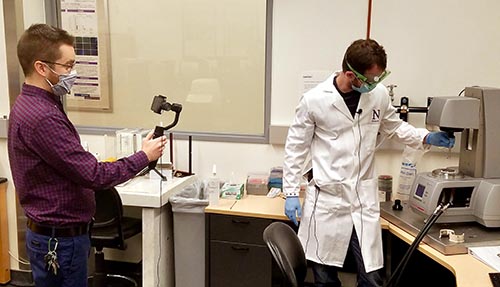ANTEC enhances training procedures during COVID-19 pandemic
Even before the COVID-19 pandemic radically altered safety protocols in research laboratories, the Analytical bioNanoTechnology Equipment Core (ANTEC) at the Simpson Querrey Institute for BioNanotechnology sought to make its user guides for core instruments more visual and easier to follow than standard equipment user manuals.
But as it became clear that physical distancing and reduced occupancy would become the new normal in their laboratory, ANTEC director Alexandra Kolot and core technician Charles Bressan realized they needed to do even more to supplement in-person training for ANTEC’s highly technical equipment.
Starting in the summer of 2020, ANTEC overhauled its training procedures, enhancing hands-on guidance with a combination of illustrated, step-by-step user guides and detailed instructional videos. Ever since, the flexibility to provide either in-person or remote training has become a part of the core’s routine.

Upon requesting training and access to ANTEC equipment, users receive their step-by-step guide and a video training via SharePoint. These materials are then combined with in-person or Zoom-based trainings in which Bressan assists new users until they are comfortable operating the equipment. This way, all trainees receives a safe and standardized introduction to the instruments they need for their research.
A key advantage of the videos is that they are concise and tailored to ANTEC’s research environment and the type of testing and processes commonly used by laboratory clients. This is in stark contrast to user manuals from manufacturers, many of which contain dozens or even hundreds of pages of highly technical text.
“Our visual, user-friendly training materials can guide a user with no knowledge of the instrument to getting meaningful results,” Kolot said. “The elaborate training manuals are now condensed into videos ranging from 20 to 30 minutes that detail the procedure from start to finish.”
Developing videos for seven different instruments was a major undertaking and a key component of the revamped training process. Planning for the project began in April 2020, while filming and editing started over the summer — with the order of video production prioritized by user need.
“Even for some of the more difficult and sensitive instruments that required the full Zoom training experience in addition to the videos, we were able to train new users and they progressed and accomplished what they planned,” Bressan said. “They have been happy and satisfied with the process.”
Bressan worked with program assistants Bradley Tallon and Jose De La Torre to adapt his in-person trainings to a video-friendly format. Tallon led the filming and editing and even produced the music that is included in the introduction and closing of each video.
“There is no replacement for in-person training, support and assistance,” Kolot said. “But now we have a library of training videos that are immediately available to core users as a quick reference or at times when in-person interactions are limited. Our team produced high-quality, user-friendly training materials that will serve the researchers for the lifetime of the instruments.”
This article was originally published in March 2021, but has been updated.
